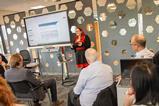
Need to know:
- Before investing in a digital healthcare solution, employers must consider their end goal, as well as the demands of the end-user.
- Organisations should build a strategy to ensure that digital interventions make a real difference to those employees that need it, rather than providing the newest trends.
- Virtual health can have a significant impact on the lives of employees, opening up health services that were previously difficult to access.
Reaching employees with support and guidance around health and wellbeing has never been easier; continual advancements in technology mean employers can reach all members of staff at the touch of a button, wherever their place of work.
The Employee Benefits benefits research 2019, published in May 2019, found that digital communication is the most popular method of reaching employees with support relating to the full gamut of physical (33%), mental (32%), financial (31%) and social wellbeing (27%).
The world is becoming increasingly digital, but how might this impact workplace healthcare and wellbeing strategies?
Valuable investment
Investing in health and wellbeing technology is a win-win for employers and employees, says Dr Chris Tomkins, head of proactive health at Axa PPP Healthcare: “There’s a clear benefit to the employer in terms of productivity, and there's also a big corporate social responsibility [CSR] element. People spend a lot of time at work, and even though their health is a result of both home and work, there’s a benefit for the employer to take action.
"The wider social responsibility is that we have some very significant challenges in the future in terms of diabetes or cardiovascular disease [for example], and that’s something that will have a very material impact on future economy. Everything we can do to tackle it now will be a big win-win.”
Employer demands
The digital healthcare market is fairly crowded, and while this provides multiple options for any organisation looking to update its package, it does mean that careful choices need to be made.
Colin Barnes, director, propositions and development, at Aon, says: “Wellbeing has really exploded in the last four or five years, driven by consumer demand. [Employers] need to decide what it is they are trying to influence and then try to work out where technology can play a part, and make sure they have the right technology to drive changes in behaviour."
As with consumer technology, a digital employee health offering should, as a hygiene factor, deliver immediacy and ease of access. To be truly effective, it may also need to serve diverse, multi-geographic, and even multinational workforces, all of whom might have different needs, expectations and legislative contexts.
One universal, however, is that end users are coming to demand the same service they receive in their lives outside of work.
“We’re seeing expectations now in healthcare from customers that are much the same as any other industry,” says Rob Edmundson, transformation and marketing director at Bupa. “Customers don’t necessarily delineate between an experience that they’re used to on Netflix or Amazon and what they want in healthcare.”
Real impact
Employers must be careful to implement digital healthcare solutions that make a notable difference to employees’ wellbeing.
Introducing wearable technology because it is an interesting new fitness trend, for example, rather than as part of an established strategy to build up employees' health, will do little to counter the initial problem.
“What we are trying to achieve here is to reach the people who genuinely need to improve their health, those who have built up health risks,” says Tomkins. “We don’t want to make a lot of fit people fitter, clearly that’s not very beneficial for the business and can also act as a disincentive to the people who really need to engage.”
Digital healthcare can provide invaluable data, which employers can use to assess where to spend budget or how to target strategies in order to create sustained behavioural change.
Nick Read, managing director at Vitality Programme, says: “Our role is to look at those key metrics and those behaviours and to try and improve them, using technology as a basis to do that.”
Digital programmes can also be used as an easy, quick way to reward employees for noticeable changes as a result of these strategies. Whether automated to give perks to employees that reach specific fitness goals, or simply providing managers an immediate medium for recognition, mobile and online technology means programmes can become more motivating than ever.
Virtual experience
Digital health and wellbeing is not just about step challenges and points for healthy eating. In fact, an area in which technology is revolutionising the employee experience is in providing easy access to vital services.
This is most notable in the rise of virtual GPs, where employees are able to have a telephone or video call with a medical professional, get onward referrals and receive access to prescription writing and delivery services.
Giving employees access to these services at their fingertips helps avoid the double edge of staff either taking time out for appointments that need only take a short time, or feeling unable to do so, deferring appointments and worsening health conditions in the long run.
Future developments
As the conversation around mental health grows, and more employers begin to see the importance of supporting employees' emotional resilience, digital support services are also gaining traction in this field.
Various providers have recently launched programmes that provide elements such as one-to-one coaching, help in building healthy behaviours, mental health management and access to mindfulness exercises. Some services, for example, use a mood meter to help individuals track their own emotional resilience, and when necessary signpost them towards a confidential advice service.
Another area that will be a key focus in the future is that of DNA testing, creating unique health and wellbeing plans based around an individual’s genetic composition. “Our first step into DNA analysis [will] create a more personalised and enriched assessment. The whole field of DNA and genomics will be a big theme in the future,” says Edmundson.
Whether complex, futuristic advances such as these forays into genetics, or simply making time consuming doctor's visits a thing of the past, developments in digital healthcare are evidently forging the path towards a healthier, happier working population.
Read more...
RSK employees use technology to track steps in pedometer challenge
Ian McKenna: Gamified apps help employees engage with benefits
































